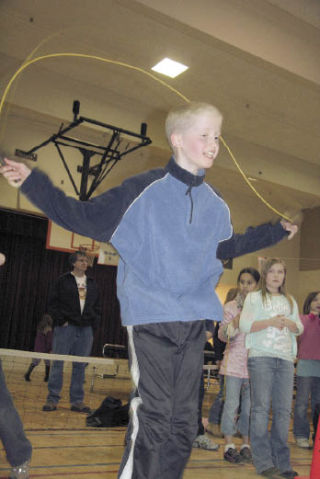Snoqualmie Elementary School’s gym was jumping and shaking last week, as hundreds of students jumped rope to raise money for the American Heart Association. The weeklong event is indicative of a fundamental shift in physical education toward a more comprehensive curriculum focused on health and fitness, rather than just refereeing games.
Facing each other, two rows of children frantically jumped rope to up-tempo rock tunes, while other children queued up, eager for their turn on the jump line.
“It feels good to help people,” said fifth-grader Marian McCandless.
Her classmate, Amanda Antoch agreed, adding, “and it’s fun to help people!”
Off to one side, Jim McEldowney, Snoqualmie Elementary School’s physical education teacher, was emceeing the event, calling out turns on the jump line and keeping the music going.
Each day, around 250 pupils jump rope during their lunch recess, and the majority of the school’s students participate at least one day, he said.
“They absolutely love it. I get asked at the beginning of the year, ‘when’s Jump Rope for Heart’?” McEldowney said.
Fifth-grade student Katie Richardson appreciates the event.
“It helps you get healthy, and it’s for a good cause,” she said.
The event typically raises around $5,000 for the American Heart Association.
More important, it offers a chance to engage students in talking about heart health, McEldowney said. During February — national heart month — he keeps a wall of honor for people in students’ lives who have been affected by heart problems.
The wall, McEldowney said, offers an opportunity to talk about what the heart does, such as how it pumps blood, which carries oxygen and nutrients.
“Or sometimes I would get out the stethoscopes,” and let the younger kids listen to own heart rates, he said.
This approach is part of a fundamental shift over the past ten or twelve years in physical education toward a more comprehensive curriculum focused on health and fitness.
“The old PE teachers used to throw out the balls and let the kids play,” McEldowney said. “There still is play, but there is more emphasis on other things,” especially overall health.
The change has been gradual, said McEldowney, who started as a physical education teacher in 1987.


